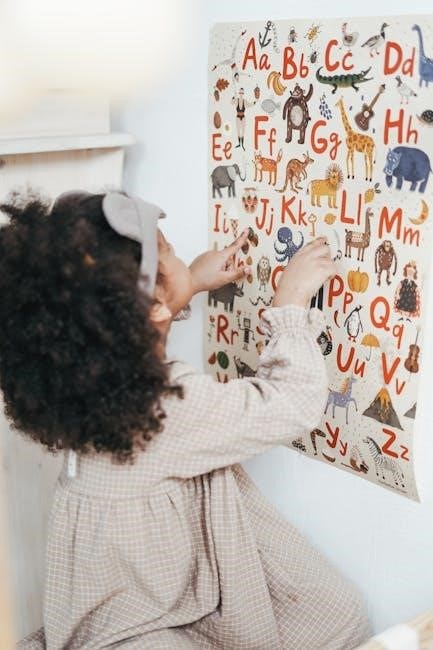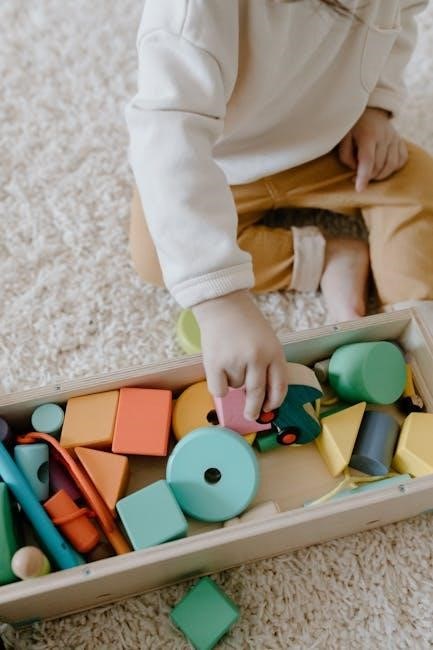Kindergarten Think Sheets are interactive tools designed to promote self-reflection, emotional growth, and positive behavior in young learners. They help children identify feelings, analyze actions, and develop better choices, fostering responsibility and critical thinking skills in a structured, engaging way.
1.1 Overview of the Think Sheet Concept
Kindergarten Think Sheets are interactive tools designed to help young students reflect on their actions and emotions. These sheets guide children in identifying how they feel, why they feel that way, and what they can do to improve their behavior. They often include visual elements like pictures or choices to accommodate limited reading skills. The concept focuses on promoting self-awareness, accountability, and positive decision-making. Think Sheets are typically used after minor disruptions or as a preventative measure to encourage better choices. They are simple, structured, and visually engaging, making them effective for kindergarteners. By fostering reflection and critical thinking, these tools support emotional growth and social development in a fun and accessible way.
1.2 Historical Background and Development
The concept of Kindergarten Think Sheets emerged as a response to the need for tools that promote self-reflection and positive behavior in young students. Rooted in educational psychology, these sheets draw from theories of emotional intelligence and restorative practices. Initially, they were simple reflection tools used in classrooms to help children process their actions and feelings. Over time, they evolved into structured resources with visual aids and guided questions, making them more accessible for kindergarteners. The development of digital and PDF formats has further enhanced their accessibility, allowing teachers and parents to easily download and customize them; Today, Think Sheets are widely recognized as effective tools for fostering emotional growth and social skills in early childhood education.

Design and Structure of Think Sheets
Kindergarten Think Sheets are designed with visual aids, guided questions, and interactive elements to help young learners reflect on their actions and emotions in a simple, engaging way.
2.1 Key Components and Features
Kindergarten Think Sheets typically include guided questions, visual aids, and interactive elements to help children reflect on their emotions and actions. They often feature sections for identifying feelings (e.g., mad, sad, confused) and understanding why those emotions arose. Additionally, they may include spaces to describe the behavior issue and suggest better choices for the future. Some sheets incorporate pictures or illustrations to cater to young learners with limited reading skills. Many also require student and teacher signatures, promoting accountability and collaboration. These tools are designed to be simple, engaging, and effective in fostering self-awareness and positive behavior in kindergarteners.
2.2 Visual and Interactive Elements
Kindergarten Think Sheets often incorporate visual and interactive elements to engage young learners. These may include pictures, emojis, or illustrations to help children identify emotions like anger, sadness, or confusion. Interactive features such as checkboxes, drawing areas, or selectable options allow students to express their feelings and thoughts visually. Some sheets include spaces for children to draw or write about their experiences, making the process more hands-on and accessible. These elements cater to kindergarteners’ limited reading skills, ensuring they can participate fully. The combination of visual aids and interactive components makes the Think Sheets both fun and effective tools for fostering self-reflection and understanding.
2.3 Age-Appropriateness for Kindergarteners
Kindergarten Think Sheets are specifically designed to meet the developmental needs of young children. They use simple language, colorful visuals, and engaging formats to capture the attention of kindergarteners. The sheets often include pictures or emojis to help children identify and express their emotions, making them accessible for those with limited reading skills. Interactive elements, such as drawing spaces or checklists, allow children to participate actively without feeling overwhelmed. The focus is on fostering self-reflection and understanding in a way that is both fun and non-intimidating. By aligning with the cognitive and emotional abilities of five-year-olds, these tools create a safe and supportive environment for early learning and personal growth.

Benefits of Using Think Sheets
Think Sheets promote self-reflection, emotional growth, and problem-solving skills in kindergarteners. They encourage children to identify feelings, analyze actions, and develop better choices, fostering accountability and personal growth.
3.1 Promoting Emotional Development
Kindergarten Think Sheets play a vital role in fostering emotional development by helping children recognize, understand, and manage their feelings. These tools provide a structured format for young learners to identify emotions such as anger, sadness, or confusion, and reflect on the reasons behind them. By encouraging self-reflection, Think Sheets guide children in understanding the impact of their actions and developing empathy. This process helps kindergarteners build self-awareness, take accountability for their behavior, and learn healthier ways to express and regulate their emotions. Over time, this leads to improved emotional intelligence, which is essential for positive social interactions and personal growth.
3.2 Enhancing Academic Performance
Kindergarten Think Sheets contribute to enhanced academic performance by fostering a structured and reflective learning environment. These tools help students develop essential skills such as problem-solving, critical thinking, and self-regulation, which are crucial for academic success. By encouraging children to reflect on their actions and choices, Think Sheets promote focus and accountability, reducing classroom disruptions. This enables students to stay on task, complete assignments, and engage more effectively in learning activities. Additionally, the emotional stability and confidence gained through using Think Sheets translate into improved participation and overall academic outcomes, creating a strong foundation for future educational growth.
3.3 Fostering Social Skills and Problem-Solving
Kindergarten Think Sheets play a significant role in fostering social skills and problem-solving abilities. By encouraging reflection on actions and their consequences, these tools help children develop empathy and understanding of how their behavior impacts others. They prompt students to think critically about better choices and solutions, enhancing their ability to resolve conflicts and interact positively with peers. The structured format of Think Sheets guides young learners in identifying feelings, analyzing situations, and considering alternative actions, which strengthens their social-emotional intelligence. This reflective process not only improves classroom behavior but also equips children with essential life skills for navigating social challenges and building positive relationships.

Implementation Strategies
Kindergarten Think Sheets can be effectively implemented in classrooms and at home, fostering consistency and collaboration between teachers and parents to promote positive behavior and reflection.
4.1 Integrating Think Sheets in the Classroom
Integrating Kindergarten Think Sheets into the classroom involves introducing them during the first few weeks of school to establish behavior expectations. Teachers can model their use after minor disruptions, guiding students to reflect on their feelings and actions. The sheets should be simple, with visual aids like emotion icons and behavior choices, making them accessible for young learners. Consistency is key; using Think Sheets regularly helps students develop self-awareness and accountability. Teachers should provide individualized support, especially for those with limited reading skills, ensuring everyone can benefit. By incorporating Think Sheets into daily routines, educators create a structured, positive environment that encourages growth and responsibility.
4.2 Using Think Sheets at Home
Using Kindergarten Think Sheets at home reinforces the lessons learned in the classroom, helping children develop consistency in their behavior and reflection practices. Parents can download free PDF versions of these sheets, which are designed to be simple and visually engaging for young children. By using Think Sheets at home, parents can help their child identify feelings, reflect on actions, and plan better choices. This tool fosters emotional development and responsibility, creating a supportive environment for growth. Parents are encouraged to discuss the sheets with their child, guiding them through the reflection process and praising their efforts to improve. This collaboration between home and school strengthens the child’s ability to manage emotions and behaviors effectively.
4.3 Teacher and Parent Collaboration
Teacher and parent collaboration is essential for maximizing the effectiveness of Kindergarten Think Sheets. By working together, educators and parents can ensure consistency in teaching positive behavior and emotional regulation. Teachers can share Think Sheets with parents, providing insights into the child’s progress and areas for improvement. Parents can reinforce these lessons at home, fostering a unified approach to the child’s development. Regular communication, such as through notes or meetings, helps align strategies and goals. This partnership not only strengthens the child’s understanding of expectations but also builds trust and cooperation between home and school, creating a supportive environment for the child’s growth and success.

Digital and PDF Versions
Digital and PDF versions of Kindergarten Think Sheets offer flexibility and convenience. PDFs are easily downloadable and printable, while digital versions provide interactive features, enhancing engagement and accessibility for young learners;
5.1 Features of Digital Think Sheets
Digital Think Sheets offer interactive features like dropdown menus, checkboxes, and drawing tools, making them engaging for kindergarteners. They can be accessed on tablets or computers, allowing for real-time feedback and progress tracking. Visual elements, such as emojis and images, help young learners express emotions and choices effectively. Digital versions often include audio prompts and animations to maintain attention. Teachers can customize templates to suit individual needs, while parents can easily access and review their child’s work. These tools foster a dynamic learning environment, blending fun with education. The ability to save and edit work ensures continuity in development. Digital Think Sheets are a modern, efficient way to support emotional and academic growth in early childhood education.
5.2 Accessibility and Convenience of PDF Formats
PDF versions of Kindergarten Think Sheets are widely accessible and convenient for teachers and parents. They can be easily downloaded and printed, making them ideal for use in both classroom and home settings. PDFs are compatible with most devices, ensuring universal access without the need for specialized software. Their print-friendly format allows for physical use, which is often preferred for young children. Additionally, PDF Think Sheets are often free or low-cost, making them a budget-friendly option for educators. Their simplicity and portability ensure that they can be used flexibly, supporting consistent behavior management and skill development. This accessibility makes PDFs a practical choice for promoting learning and reflection in early childhood education.
Cultural and Individual Sensitivity
Kindergarten Think Sheets are designed to be inclusive, respecting diverse cultural backgrounds and individual needs. They promote sensitivity by fostering an environment where every child feels valued and understood.
6.1 Ensuring Inclusivity in Think Sheets
Kindergarten Think Sheets are designed to be inclusive, respecting diverse cultural backgrounds and individual needs. They incorporate visual aids and simple language to ensure accessibility for all learners. By addressing emotional and behavioral challenges in a non-judgmental way, these tools foster a sense of belonging. Educators can customize Think Sheets to accommodate different learning styles and cultural contexts, ensuring every child feels valued. This inclusivity promotes a positive and equitable learning environment, allowing all students to benefit from the reflective and growth-oriented process. The adaptability of Think Sheets makes them a powerful resource for supporting diverse student populations effectively.
6.2 Personalizing for Individual Needs
Kindergarten Think Sheets can be personalized to meet the unique needs of each child, ensuring they are effective for diverse learners. Educators can tailor the content to match individual learning styles, incorporating visual aids or simplified language for those with limited reading skills. For children with specific emotional or behavioral challenges, Think Sheets can focus on relevant scenarios or feelings, helping them process experiences more effectively. Additionally, parents and teachers can adapt the sheets to align with a child’s developmental stage, providing age-appropriate prompts and reflections. This customization enhances engagement and ensures that every child can benefit from the reflective process, fostering personal growth and understanding; Personalization makes Think Sheets a versatile tool for supporting individual development in young learners.

Effectiveness and Impact
Kindergarten Think Sheets are effective tools for promoting self-reflection, critical thinking, and positive behavior. They help children process feelings, actions, and consequences, fostering accountability and better decision-making skills.
7.1 Research Studies and Data
Research indicates that kindergarten think sheets significantly improve self-reflection and behavior management. Studies show these tools enhance emotional understanding and reduce classroom disruptions. Data from educators highlights improved accountability and problem-solving skills in students. The structured format, including emotion identification and action analysis, fosters critical thinking. Many studies emphasize the effectiveness of visual and interactive elements in engaging young learners. Additionally, think sheets promote a positive classroom environment by encouraging responsibility and better decision-making. Overall, the evidence supports the use of think sheets as a valuable resource for fostering social-emotional growth and academic readiness in kindergarteners.
7.2 Feedback from Educators and Parents
Educators and parents consistently praise kindergarten think sheets for their effectiveness in promoting positive behavior and self-reflection. Teachers report improved classroom management and increased student accountability. Parents appreciate the clear communication and structured approach to addressing behaviors. Many highlight the tool’s ability to foster emotional awareness and problem-solving skills. The interactive and visual elements are particularly praised for engaging young learners. Feedback also emphasizes the adaptability of think sheets to individual needs, making them a versatile resource for both classrooms and homes. Overall, the positive feedback underscores the value of think sheets in supporting social-emotional development and creating a collaborative learning environment.

Challenges and Solutions
Challenges include limited engagement from some students and time constraints for teachers. Solutions involve creating interactive, visually appealing designs and providing pre-designed templates for easier implementation and accessibility.
8.1 Common Limitations and Challenges
Kindergarten Think Sheets face challenges such as limited engagement from younger students who may struggle with self-reflection. Some children find it difficult to articulate their emotions or understand the consequences of their actions. Additionally, the effectiveness of Think Sheets can vary depending on individual learning styles and the level of support provided by educators. Time constraints and the need for consistent implementation can also pose challenges for teachers; Furthermore, the reliance on visual and interactive elements may not always cater to all learning preferences, potentially limiting their impact for some students. Addressing these challenges requires tailored strategies to ensure the tool’s effectiveness across diverse learning needs.
8.2 Strategies to Overcome Obstacles
To address challenges, educators can simplify Think Sheet language and incorporate more visuals for younger students. Providing one-on-one support and modeling self-reflection helps students grasp the concept. Teachers can also integrate Think Sheets into daily routines, ensuring consistency and familiarity. Offering incentives for thoughtful responses can motivate participation. Additionally, training educators on effective implementation strategies enhances their ability to support students. Collaborating with parents to reinforce reflection at home further strengthens the tool’s impact. By adapting Think Sheets to individual needs and learning styles, educators can maximize their effectiveness and help students develop essential life skills. Consistency, creativity, and collaboration are key to overcoming obstacles and ensuring successful outcomes.
Kindergarten Think Sheets are powerful tools fostering emotional and academic growth. Their versatility in both physical and digital formats ensures accessibility. Future advancements will enhance their interactivity and reach, benefiting more educators and students.
9.1 Summary of Key Points
Kindergarten Think Sheets are innovative tools designed to foster emotional growth, self-reflection, and problem-solving skills in young learners. They provide structured formats for children to identify feelings, analyze actions, and consider consequences, promoting accountability and better decision-making. These sheets are versatile, suitable for both classroom and home use, and are particularly effective in addressing minor behavioral incidents. By encouraging critical thinking and ownership of actions, they support social-emotional development and academic readiness. Their simplicity and visual appeal make them accessible to kindergarteners with limited reading skills. Overall, Think Sheets are valuable resources for educators and parents aiming to create a positive, structured learning environment that nurtures both emotional intelligence and academic success.
9.2 The Future of Think Sheets in Education
The future of Kindergarten Think Sheets lies in their adaptability to evolving educational needs. As digital tools become more prevalent, interactive Think Sheets may incorporate real-time feedback and multimedia elements, enhancing engagement. Their accessibility in PDF and digital formats ensures they remain versatile for both classroom and home use. The integration of technology could allow for personalized learning experiences, tailoring Think Sheets to individual student needs. Additionally, their focus on emotional intelligence and problem-solving aligns with modern educational priorities, making them a valuable resource for fostering well-rounded development. As educators continue to seek innovative ways to support young learners, Think Sheets are poised to remain a cornerstone of early childhood education, bridging traditional and digital learning seamlessly.

Additional Resources
Download free Kindergarten Think Sheets in PDF format from various educational websites. Visit stores like TPT for editable versions and additional activities. Explore further reading and references for enhanced learning.
10.1 Download Links and Availability
Kindergarten Think Sheets are widely available online in PDF format, offering convenience for teachers and parents. Popular platforms like Teachers Pay Teachers (TPT) and Free Printable Behavior Charts provide free and editable versions. Many websites, such as Free Printable Behavior Charts, offer downloadable resources designed for young learners. These sheets are often colorful, engaging, and tailored to meet the needs of kindergarteners with limited reading skills. Additionally, some resources are available in Google Classroom format, making them easily accessible for digital use. When downloading, ensure the content aligns with your specific needs, whether for behavior reflection, emotional development, or academic support. Always check for the most recent updates to access the latest designs and features.
10.2 Further Reading and References
For deeper insights into Kindergarten Think Sheets, explore resources like Free Printable Behavior Charts and educational blogs. These platforms offer guides on designing effective think sheets, incorporating visual aids, and aligning them with classroom goals. Additionally, Teachers Pay Teachers (TPT) provides extensive collections of customizable templates and activities. Research articles highlight the role of think sheets in fostering emotional intelligence and problem-solving skills. For practical tips, refer to educational YouTube channels like “Learn with Advit,” which share creative ways to use these tools. These resources collectively provide a comprehensive understanding of implementing think sheets in both classroom and home settings, ensuring a well-rounded approach to child development.

